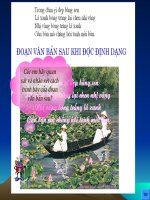1 2 dinh dang bang
Bạn đang xem bản rút gọn của tài liệu. Xem và tải ngay bản đầy đủ của tài liệu tại đây (647.1 KB, 14 trang )
Water-Saving
Landscaping
Low-maintenance solutions
for intermountain regions
2
April 18, 2010
Challenges
Hot
temperatures
Cold temperatures
Shorter growing season
Drying winds
Deluge/drought
Poor soil
Water-Saving Landscaping
3
April 18, 2010
Solutions
Windbreaks
Xeriscaping
Soil
amendment
Native plants
Water-Saving Landscaping
4
April 18, 2010
Windbreaks
Structures
Fences
Walls
Water-Saving Landscaping
5
April 18, 2010
Windbreaks
Plants
Tree lines
Hedges
Water-Saving Landscaping
6
Water Cycle
April 18, 2010
Clouds
Evaporation
and
Transpiration
Condensation
and
Precipitation
Runof
and
Percolation
Water-Saving Landscaping
7
April 18, 2010
Water Consumption
200
175
150
125
100
75
50
25
0
Average
Conservative
t h nds lush ing in.) at h her and her in.)
e
s
s
e ha
f hav
B
h
m
m
t
a
a
t
y
8
0
g
e
w
w
(
l
g
b
S
r
sh es hes n (2
hin shin Toi
i
e
s
D ish ot
u
w Water-Saving Landscaping
ow
a
l
h
Br Wa
L
D
C
S
8
April 18, 2010
Xeriscaping
Planting
strategies that conserve water
Water-Saving Landscaping
9
April 18, 2010
Xeriscaping
No
additional watering
Water-Saving Landscaping
10
April 18, 2010
Xeriscaping
Drip
irrigation
Water-Saving Landscaping
11
April 18, 2010
Soil Amendment
Eastern
Washington loses more than
10 tons of soil per acre per year
to rainfall runof
Source: Atlas of U.S. Environmental Issues, Mason & Mason, 1990
Water-Saving Landscaping
12
April 18, 2010
Native Plants
Tolerate
temperature range
Tolerate drought
Prevent erosion
Support natural ecosystem
Attract pollinators
Need little or no maintenance
Sustainable
Water-Saving Landscaping
13
April 18, 2010
Temperature Range
Seasonal Temperatures
Winter
Spring
Summer
Fall
Minimum
18
41
73
43
Average
29
57
89
54
Maximum 40
72
105
65
Water-Saving Landscaping
14
April 18, 2010
Native Plants
Photos courtesy of Rugged Country Plants
Water-Saving Landscaping









